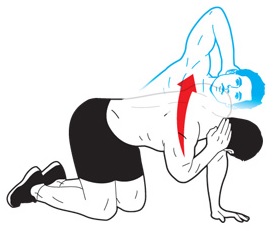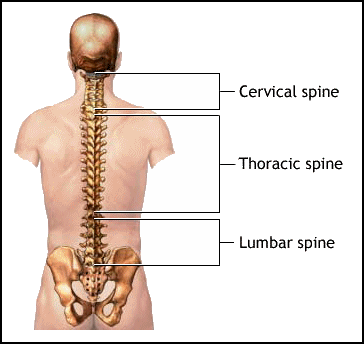Breaking Down the Quadruped Thoracic Rotation
Thoracic mobility is kind of a big deal. It’s a major driver for often overlooked things like breathing and walking. I mean, who needs to do either of those things during their day, am I right? Sure, getting some rotation is awesome for throwing something or pressing something over your head, but a lot of people wind up losing that ability after years of sitting in office chairs or cars, and by figuring out really cool ways to get rotation from other areas and figuring out some sweet compensations.

The quadruped rotation, pictured above, is a very common method for training some rotation through the thoracic spine, but as with any complex movement there’s a bunch of technique pointers to help get the best benefit from the movement and to not wind up a snapped up version of your best self.
The first scene shows a flexed neck and rounded shoulders during the movement. This is a common issue with people who may not have the shoulder flexibility to get their hand behind their head without pulling their head down. A rounded T-spine tends to rotate less effectively than an extended spine, so trying to get the head to push back into the hand and getting the chest up and out would be the best correction for this position. If the person can’t get into an extended state with the hand behind the head, there’s the option of putting the hand on the opposite shoulder to reduce the need for shoulder flexion.
The second scene shows some uncontrolled movement from the shoulders and hips. The downside to these secondary compensations are that they’re the joints doing movement, not the thoracic spine. The movement is also a bit too fast and uncontrolled, which can affect the stretch reflex of muscles controlling the movement and could actually tense up the response of the tissues to the stretch. Go slow and controlled, yo.
Third, you have a flexed neck and shoulders, and also limited drive from the base arm, which means you’re limiting thoracic rotation by not pivoting on the shoulder. Essentially, think of moving the torso around the shoulder in an arch.
Next, from no shoulder drive to too much. Here the shoulder is driving horizontally and going through way too much movement. Essentially, you’re using the shoulder to do the work versus getting the thoracic spine to do work. There’s also some serious lateral flexion going on that could be a bit tough to see.
Following that, there’s some uncontrolled lateral hip drive that’s compensating for the thoracic motion. Essentially, all of the range is coming from side to side shift from the hips. Keep those puppies stable, and enjoy the view.
After this, I show a couple of variations of controlled rotations. Some key points to consider here are that the neck is in line with the rest of the spine, the hips are staying still and not rotating, and the rib cage is rotating around the shoulder pressed into the floor. There’s also slow controlled contractions with a deep exhale at the top of the stretch, and the position is held for a full breath cycle to ensure the stretch reflex isn’t just popping you back into the starting position.
The final version is the shoulder braced rotation, which is similar, but a stepped down variation that doesn’t require the shoulder flexion range of motion or neck strength to hold things together.
It can be tough to do something like this on your own without some feedback from someone who knows what they’re doing in coaching, but you can get around this by filming yourself and seeing if the movement is coming from the thoracic spine, or if you’re getting movement from the low back, hips or shoulders, or if you’re getting some lateral flexion from the spine instead of from rotation.

Go slow with these, focus on getting a good inhale and exhale at the peak range position, and don’t try to get range for the sake of range if it means you’re borrowing from different joints that aren’t supposed to contribute to the movement.
One Response to Breaking Down the Quadruped Thoracic Rotation